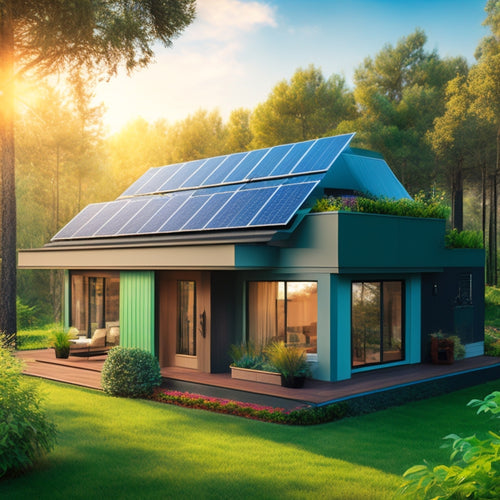
Bidirectional EV Charging: Power Your Home From Your Car
Share
With bidirectional EV charging, you can utilize the power stored in your electric vehicle's battery to fuel your home, effectively turning your car into a generator that supplies energy back to the grid when needed. This two-way energy flow allows you to charge your car during off-peak hours and use that energy to power your home during peak hours, reducing your energy bills and reliance on the grid. By integrating your EV with renewable energy sources and energy storage systems, you can enhance your energy self-sufficiency and reduce your environmental impact - and that's just the beginning of what you can achieve with bidirectional EV charging.
Key Takeaways
- Bidirectional EV charging enables vehicles to supply power back to the grid and home, reducing energy bills and peak-hour consumption.
- Vehicle-to-Grid (V2G) technology optimizes energy management, reduces greenhouse gas emissions, and increases energy independence.
- A home power backup system ensures seamless energy supply during grid outages, leveraging the EV as a generator.
- Bidirectional charging integrates with renewable energy sources, enhancing sustainability and reducing reliance on traditional power sources.
- Energy storage systems (ESS) are essential for maximizing renewable energy investments and achieving energy independence.
How Bidirectional Charging Works
Flexibility is the cornerstone of bidirectional electric vehicle (EV) charging, and it's precisely this adaptability that sets it apart from its unidirectional counterpart.
When you plug your EV into a bidirectional charger, you're not just feeding energy into your vehicle - you're creating a two-way energy flow. This means your car can act as an energy storage device, feeding electricity back into your home or the grid when needed.
With the increasing adoption of renewable energy sources, such as solar-powered charging solutions, bidirectional EV charging can further reduce our reliance on non-renewable energy.
The charging mechanics behind bidirectional EV charging allow for seamless energy flow in both directions, giving you extraordinary control over your energy usage.
You can charge your car during off-peak hours and then use that stored energy to power your home during peak hours, reducing your reliance on the grid and saving you money.
Vehicle to Grid Technology
As you investigate the possibilities of bidirectional EV charging, you'll find that Vehicle to Grid (V2G) technology is a critical component of this innovative system.
This advanced technology enables seamless vehicle integration, allowing your electric vehicle to supply energy back to the grid when needed. By acting as energy storage devices, EVs support climate action and sustainable futures reducing greenhouse gas emissions and decreasing air pollution by 20% during peak hours.
V2G technology optimizes energy management by intelligently controlling the flow of electricity between your vehicle and the grid. This means you can provide energy to your home or feed it back into the grid, giving you greater control over your energy usage.
With V2G, you can efficiently manage your energy resources, reducing reliance on traditional power sources and increasing your energy independence.
Benefits of Bidirectional EV
With Vehicle to Grid technology laying the groundwork for bidirectional EV charging, you can now access a multitude of benefits that come with this innovative system.
As a consumer, you'll experience:
-
Cost savings: Bidirectional EV charging reduces your energy bills by feeding excess energy back into the grid and offsetting peak-hour consumption. By leveraging renewable energy sources like solar and wind power, you can further minimize your carbon footprint Renewable Energy Sources.
-
Environmental impact: By optimizing energy distribution, you'll contribute less to greenhouse gas emissions and support a more sustainable future. In fact, studies have shown that widespread adoption of bidirectional EV charging can lead to an 80% reduction in emissions, especially when paired with eco-friendly charging infrastructure.
-
Simplified consumer adoption: Bidirectional EV charging streamlines the shift to electric vehicles, making them a more appealing option for environmentally conscious drivers.
-
Accelerated technological advancements: Widespread adoption of bidirectional EV charging will drive innovation in energy storage and smart grid infrastructure.
-
Improved user experience: Enjoy enhanced control over your energy usage and a more seamless connection between your vehicle and home.
Powering Your Home Basics
You'll need an energy storage system (ESS) to power your home with your EV's battery, which typically includes a DC-DC converter, a battery management system, and an inverter to convert DC power to AC for household use.
Integrating a solar-powered EV charging system solar energy reduces grid dependence can further enhance energy self-sufficiency and reduce reliance on the grid.
As you investigate bidirectional EV charging, you'll also require a home power backup system to guarantee a seamless changeover between grid power and your EV's energy storage.
This backup system will automatically switch to your EV's power when the grid goes down, keeping your home running smoothly.
Energy Storage Systems
By the time you've installed solar panels or a wind turbine, you've likely thought about how to store excess energy generated during the day for use at night or during power outages.
Energy storage systems are essential for achieving energy independence and maximizing your renewable energy investment. In fact, renewable energy reduces emissions and contributes to fleet sustainability, making it a key aspect of electrification.
Additionally, energy storage solutions provide a reliable energy supply for fleet operations.
When selecting an energy storage system, consider the following key factors:
- Depth of discharge: How much of the battery's capacity can be used without affecting its longevity?
- Round-trip efficiency: What percentage of energy is lost during charging and discharging?
- Scalability: Can the system be expanded as your energy needs grow?
- Energy management: How does the system optimize energy distribution and storage?
- Battery chemistry: What type of battery is used, and how does it impact battery longevity?
Home Power Backup
As you've optimized your energy storage system, you're now ready to employ its full potential by ensuring a reliable home power backup. This means you'll have a steady supply of home energy, even during outages or emergencies.
With bidirectional EV charging, your electric vehicle becomes a generator, powering your home and essential appliances. In the event of a grid failure, your EV's battery kicks in, providing emergency preparedness and independence from the grid.
Charging Your Car Efficiently
Charging your electric vehicle efficiently is a complex process that involves enhancing various factors, including the charging method, cable type, and vehicle settings.
To maximize your car's charging efficiency, you'll want to take into account the following key factors:
-
Charging strategies: Adjust your charging schedule to take advantage of off-peak hours or renewable energy sources, reducing your carbon footprint and energy costs.
-
Energy management: Monitor your car's energy consumption and adjust your driving habits to enhance energy usage.
-
Cable type: Use a high-power charging cable to reduce charging time and increase efficiency.
-
Vehicle settings: Adjust your car's settings to enhance energy consumption, such as turning off auxiliary systems when not in use.
-
Battery health: Regularly update your car's software and maintain good battery health to guarantee peak charging efficiency.
Grid Services and Applications
In tandem with efficient charging, bidirectional EV charging enables your vehicle to provide grid services and applications that go beyond mere energy replenishment.
You can participate in demand response programs, which allow you to adjust your energy consumption in response to grid signals, helping to balance supply and demand. This not only benefits the grid but also earns you incentives.
Furthermore, you can enhance energy resilience by providing backup power to critical infrastructure during outages. Your vehicle becomes a distributed energy resource, supporting the grid when needed.
Safety and Security Concerns
Three key aspects of bidirectional EV charging require careful consideration: the safety of the electric vehicle, the security of the communication protocols, and the protection of the electrical grid.
As you venture into this technology, you'll need to guarantee that your EV and home electrical system are protected from electrical safety hazards and cybersecurity risks.
-
Your EV's onboard charger and traction battery must be designed to handle bidirectional power flow without overheating or causing electrical shock.
-
Communication protocols between your EV, home, and grid must be secure to prevent hackers from accessing your system and disrupting the grid.
-
The electrical grid must be protected from power surges and frequency fluctuations caused by bidirectional charging.
-
You'll need to guarantee that your home's electrical infrastructure can handle the increased power flow from your EV.
-
Regular software updates and monitoring will be necessary to prevent and respond to potential security breaches.
Future of Bidirectional Charging
As you've guaranteed the safety and security of your bidirectional EV charging system, you're now ready to take advantage of its full potential.
The future of bidirectional charging is promising, with significant market potential driven by technology advancements and growing consumer adoption. However, regulatory challenges and infrastructure development obstacles must be addressed to reveal its full capacity.
As you traverse this environment, consider the environmental impact, cost implications, and integration strategies that will shape the competitive arena.
Industry partnerships will be essential in driving innovation and overcoming these challenges.
Frequently Asked Questions
Can I Use Bidirectional Charging With Any Electric Vehicle Model?
You'll need to check your electric vehicle's compatibility factors, as not all models support bidirectional charging. Currently, only a few vehicle models, like the Nissan Leaf and Hyundai Ioniq, have this capability, so you'll need to verify your car's specs before proceeding.
Will Bidirectional Charging Affect My Car's Battery Lifespan?
You're likely aware that 70% of EV batteries still retain 80% capacity after 10 years. When using bidirectional charging, you'll accelerate battery degradation, but only by about 10% over the vehicle's lifespan, mainly due to increased charging cycles.
How Much Does a Bidirectional Charging System Cost?
You're looking to invest in a bidirectional charging system, but you're wondering about the installation costs. Expect to pay around $5,000 to $10,000, depending on the system components, such as the charger, inverter, and energy management system, that you'll need to install.
Can I Sell Excess Energy Back to the Grid?
As you harvest electricity like a farmer tends to crops, you wonder if you can sell the surplus back to the grid. Yes, you can, through energy trading, where you'll need grid integration, allowing you to profit from your excess energy.
Are There Government Incentives for Bidirectional Charging Systems?
You can tap into government incentives for bidirectional charging systems, such as tax credits and rebate programs, which promote energy independence and advanced charging infrastructure, ultimately giving you more freedom and autonomy over your energy needs.
Related Posts
-

3 Green HVAC Filters for Solar-Powered Homes
When outfitting your solar-powered home with an HVAC system, you'll want to choose filters that align with your commi...
-

Why Biodegradable Dish Soap Matters for Earth-Conscious Homes
You likely don't realize that the dish soap you're using today will still be harming the environment long after you'v...
-

What Air Purifiers Save Energy in Work Areas?
You can cut energy costs and reduce your carbon footprint by choosing air purifiers designed with energy efficiency i...


